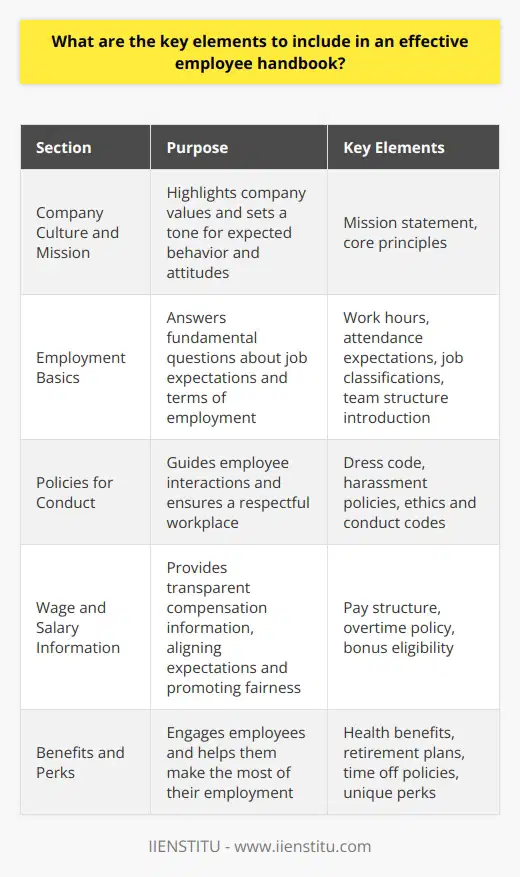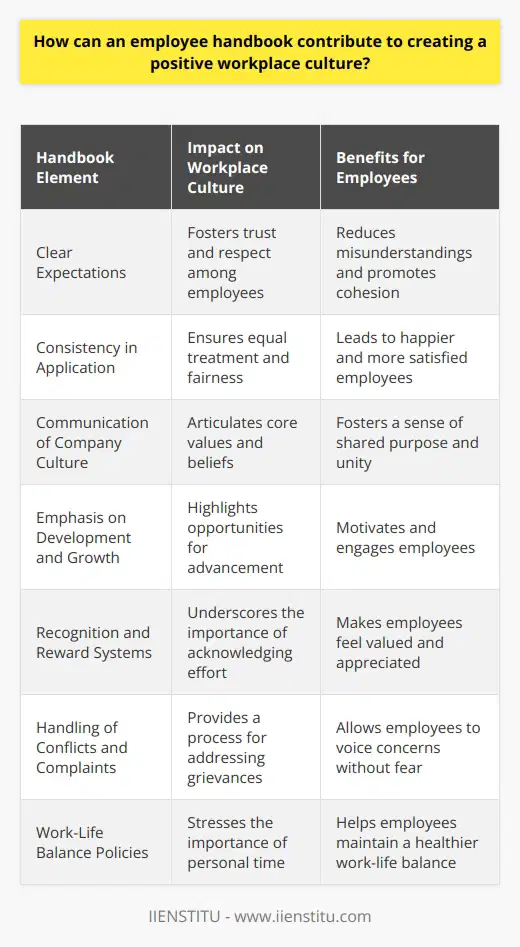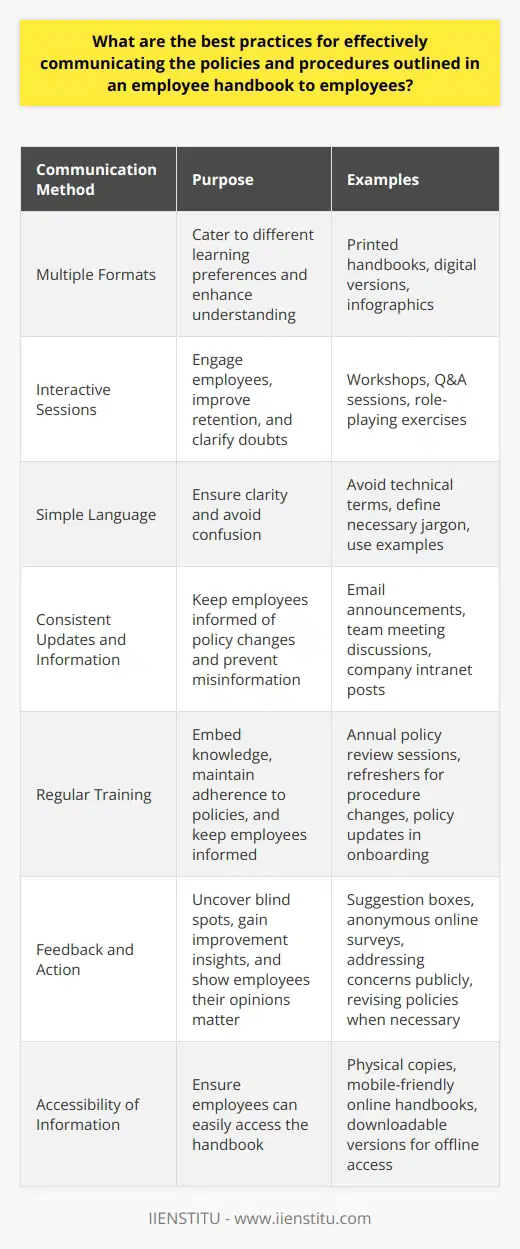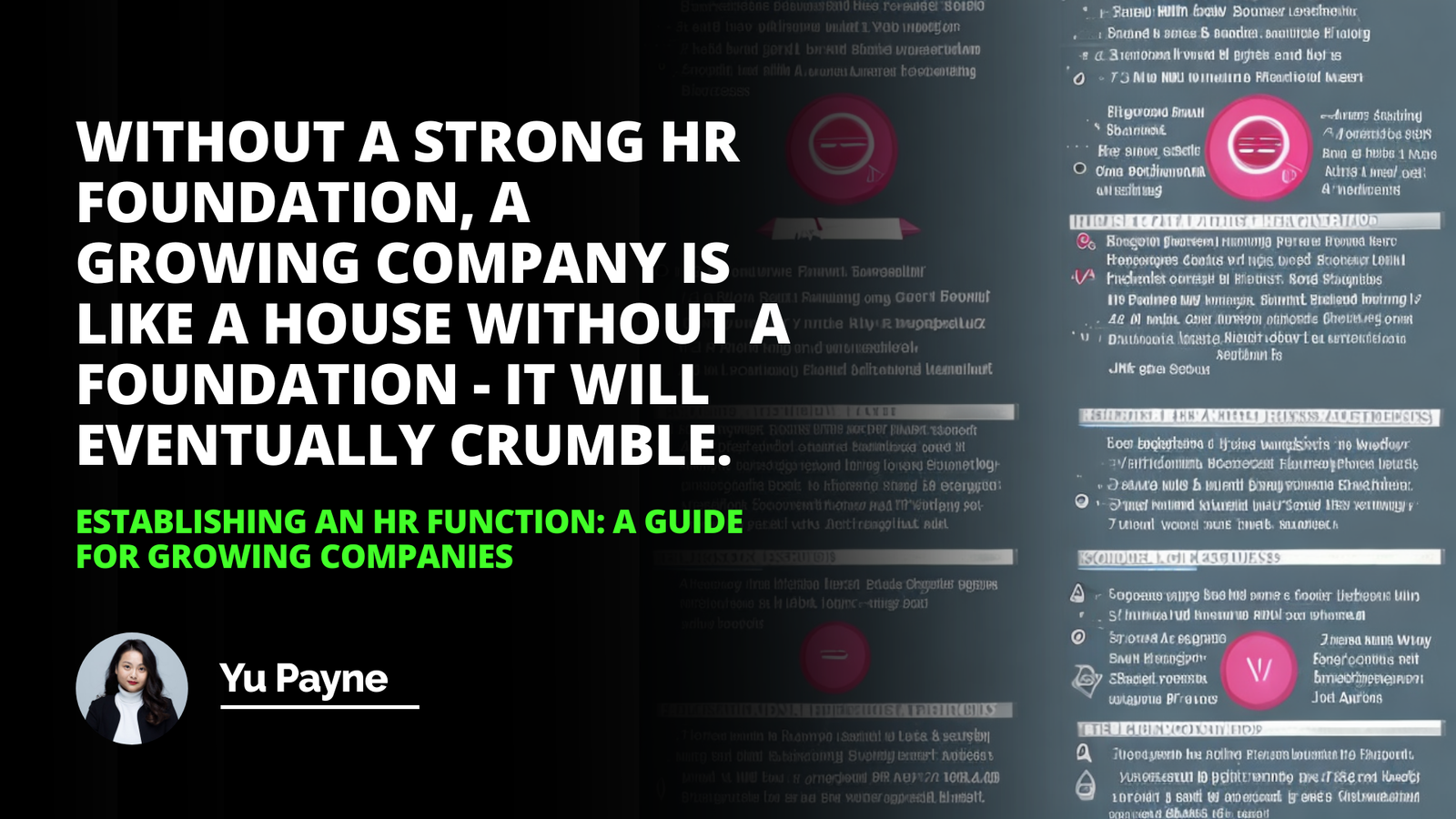
The employee handbook is a foundational document that serves as both a sword and a shield for modern businesses. It provides employees with clear expectations of their role, while also protecting the organization from potential legal pitfalls. This, traditionally printed document, has evolved into a dynamic digital resource reflective of the organization's culture, policies, and procedures. An effectively created employee handbook can foster a positive work environment, simplify onboarding, and uphold consistency within the workplace.
In this article, we will explore the critical aspects of developing an employee handbook that serves the needs of both the employer and the employee, drawing on comprehensive knowledge and an expert approach in the field of human resources.
🔊 Ready for an auditory reading experience? Just click the 'Play' button right below this text and immerse yourself in our captivating audio version. Ideal for those who prefer listening to stories, or for times when you're multitasking. Engage with our content effortlessly - one simple click is all it takes to transform your reading into listening!
The Importance of an Employee Handbook
Legal Protection: An employee handbook plays a critical role in protecting both the employer and the employees from legal issues. By providing clear descriptions of workplace policies, the handbook can serve as evidence of the company's attempt to comply with labor laws and regulations. For example, anti-discrimination policies and equal employment opportunities must be outlined clearly to avoid misunderstandings and, potentially, legal challenges. The inclusion of disclaimers and a clear at-will employment statement can further fortify the employer's position in legal disputes. HR certificate courses often emphasize the importance of ensuring handbooks are reviewed by a legal professional to mitigate risks effectively.
Setting Expectations: Setting the right expectations from the very start is vital for an efficient and harmonious workplace. The handbook is an authoritative resource for outlining what the company expects from its employees regarding performance, behavior, and compliance with company policies. This may include adherence to workplace safety guidelines, attendance expectations, or dress code requirements. By setting these expectations in writing, there is a clear benchmark against which employee performance and conduct can be measured, which is essential for maintaining order and discipline in the workplace.
Onboarding Tool: An employee handbook can be an invaluable onboarding tool for new hires. It introduces them to the culture and practices of the company, helping them assimilate more quickly and effectively. By having a centralized source of necessary information, new employees can find answers to their initial questions, like "How do I request time off?" or "What's the process for travel reimbursement?" without feeling overwhelmed. An informative handbook can reduce the time HR staff spend on addressing common inquiries, streamlining the onboarding process, and letting new employees hit the ground running.
Key Components of an Employee Handbook
Introduction and Welcome Message: The introduction of an employee handbook should warmly welcome individuals to the company and serve as an embracing overview of the business's history, mission, and ethos. It usually includes a message from the CEO or founder, which personalizes the handbook experience, and sets the tone for the culture and community within the company. This section should make employees feel valued and articulate how their contributions will support the overarching goals of the organization.
Company's Mission, Vision, and Values: An employee handbook must clearly communicate the company's mission, vision, and core values, laying a foundation for the corporate culture. This section acts as a compass that guides employee behavior and decision-making processes. For instance, if innovation is a core value, employees are encouraged to seek out and support new ideas. By aligning employees with the organization's larger purpose, they are more likely to be engaged and work towards the common objectives of the company.
General Employment Information: This section covers essential details that govern the employer-employee relationship, such as job classifications, work hours, pay schedules, and performance review procedures. Providing clarity about job duties and the employer's expectations fosters a more structured and fair work environment. Online courses in human resources often spotlight that concise communication in employment information prevents conflicts and confusion.
Workplace Policies: From attendance and punctuality to the use of company equipment, effective workplace policies address the daily operational aspects of the company. These policies ensure that all employees operate within the same set of rules, creating an environment of fairness and consistency. Clearly outlined policies help in avoiding misunderstandings and set a standard for professional behavior within the work environment.
Code of Conduct: The code of conduct section outlines acceptable standards of behavior and actions that the company considers to be unethical or unacceptable. Issues such as conflicts of interest, harassment, confidentiality, and corporate integrity are typically addressed here. A robust code of conduct supports a respectful work culture where employees feel safe and valued.
Compensation and Benefits: Compensation and benefits are central to an employee's relationship with their employer. Clearly outlining salary structures, bonus potential, benefits packages, retirement plan options, and other perks helps employees understand their entitlements and boosts attraction and retention rates. It also reduces the potential for disputes over pay and benefits.
Leave and Time Off Policies: This section details the company's various leave policies including sick leave, paid time off (PTO), family and medical leave, and other time off accommodations. By establishing clear leave policies, organizations can plan for absences without significant disruption to operations, and employees can plan their leave without confusion or uncertainty.
Termination Policies: Termination policies should be outlined with clear procedures for both voluntary and involuntary separations, including notice periods, final paycheck information, and the return of company property. This section aims to provide a respectful and legally compliant approach to the sensitive issue of employment termination.
How to Create an Effective Employee Handbook
Get Legal Input: The importance of obtaining legal counsel in the creation of an employee handbook cannot be overstated. Legal professionals with expertise in employment law can ensure that all policies comply with federal and state laws. They provide valuable insights into areas such as anti-discrimination laws, wage and hour requirements, and disability accommodations, which help prevent future legal complications.
Make it Comprehensive Yet Understandable: While an employee handbook should be thorough, it also needs to be easily understandable by employees from various backgrounds. It should avoid overly technical language, instead opting for clear, concise information that can be understood by all. Accompanying complex policies with relevant examples enables better comprehension among the workforce.
Keep it Updated: The business environment is dynamic, and employment laws change frequently. To remain relevant and enforceable, handbooks must be reviewed regularly, and updates should be disseminated promptly. Failing to update an employee handbook can lead to regulatory non-compliance and policy misunderstandings.
Get Employee Feedback: Inviting feedback from employees can provide practical insights into how the handbook could be improved or clarify which policies are not well understood or accepted. Employees are more likely to adhere to a handbook they feel they’ve contributed to, and this approach can also enhance the overall sense of inclusivity and respect in the company culture.
Make it Accessible and Well-Distributed: An effective employee handbook must be accessible to all employees. With the increasing prevalence of remote work, digital handbooks have the advantage of being readily available from anywhere at any time. Physical copies should also be distributed during onboarding, and the availability of the handbook should be well-communicated across the organization.
Common Mistakes in Drafting an Employee Handbook and how to avoid them
Being too Vague: Ambiguous policies can create confusion and lead to uneven policy enforcement. It is essential to be specific about rules, consequences, and procedures to avoid misunderstandings. Vague language can also weaken the employer's legal position during disputes.
Not Tailoring it to your Business: While many handbook templates are available, it is crucial to ensure that the content of the handbook reflects the specific practices, culture, and needs of your business. Policies should be relevant to the industry and the specific workplace dynamics of the company, which may vary greatly from one organization to another.
Overlooking Important Policies: Every company is unique, which sometimes leads to overlooking policies that are critical in a given work environment. Neglecting policies on topics such as remote work, security, or social media can leave a company vulnerable. It's important to include all relevant policies that employees must be aware of and abide by.
Neglecting to Update it: Failing to regularly review and update the handbook can result in compliance issues and policies that don't reflect current practices. Changes in law, technology, or company operations must be reflected in the employee handbook to ensure it remains a relevant and guiding document.
The Role of Digitalization in Employee Handbooks
Benefits of Digital Handbooks: Digital handbooks offer significant advantages, including ease of accessibility, the ability to update information quickly, and cost savings on printing. Interactive elements can be included, such as hyperlinks to additional resources or embedded training videos, enhancing the user experience and engagement.
Considerations when Shifting from Print to Digital: Transitioning from a printed to a digital handbook requires careful consideration of variables such as digital literacy, the security of sensitive information, and ensuring that all employees have access to the digital tools needed to review the handbook.
Utilizing Software for Handbook Creation and Updates: Specialized software can facilitate the creation, distribution, and updating of employee handbooks. These tools often include templates, legal compliance checklists, and distribution tracking to ensure handbooks reach all employees, simplifying what can be an otherwise complex and time-consuming process.
A well-crafted employee handbook serves as the backbone of effective workplace management. It fosters a culture of transparency and fairness, provides necessary legal protections, and offers a platform for consistent communication regarding company policies and procedures. With a blend of comprehensive content, legal accuracy, and careful consideration of distribution methods, the employee handbook stands as an invaluable asset in creating a productive and harmonious working environment.
Frequently Asked Questions
What are the key elements to include in an effective employee handbook?
An effective employee handbook serves a crucial role. It outlines company policies, expectations, and rights. Crafting one requires a focus on key elements. These promote clarity and compliance. They foster a productive work environment.
Core Elements of an Employee Handbook
Company Culture and Mission
Begin with your company's mission statement. This highlights company values. Employees understand the company's core principles. It sets a tone for expected behavior and attitudes.
Employment Basics
This section answers fundamental questions. It covers job expectations and terms of employment. Details should be direct and comprehensive.
- Work hours
- Attendance expectations
- Job classifications
- Introduction to team structure
Policies for Conduct
Policies for conduct guide employee interactions. They ensure a respectful workplace.
- Dress code
- Harassment policies
- Ethics and conduct codes
Wage and Salary Information
Provide transparent compensation information. This aligns expectations and promotes fairness.
- Pay structure
- Overtime policy
- Bonus eligibility
Benefits and Perks
Highlighting benefits engages employees. It helps them make the most of their employment.
- Health benefits
- Retirement plans
- Time off policies
- Unique perks
Safety and Security
A section on safety reassures employees. They know their well-being matters.
- Workplace safety protocols
- Emergency procedures
- Security practices
Technology Use
Technology rules maintain security and productivity. They make permissible uses clear.
- Acceptable use of systems
- Privacy policies
- Social media guidelines
Leave Policies
Define leave policies unambiguously. Employees can plan for life events.
- Paid time off (PTO)
- Family leave
- Sick leave
Complaint Procedures
Outline a clear process for grievances. Employees feel heard and respected.
- Steps to file a complaint
- Contact points for help
Acknowledgment Form
Conclude with a sign-off section. Employees acknowledge their understanding. This secures compliance and reduces disputes.
Employee handbooks are living documents. They should evolve with laws and company growth. Revisit and update them regularly. They are vital for a well-informed and engaged workforce.

How can an employee handbook contribute to creating a positive workplace culture?
Employee Handbook and Positive Workplace Culture
An employee handbook serves as a cornerstone. It codifies company policy and culture. The handbook is not just rules. It represents an organization's values. Employees refer to it for guidance.
Clarity in Expectations
Clear expectations foster trust and respect. Employees feel secure knowing what's expected. They understand their roles and responsibilities. This clarity reduces misunderstandings and fosters cohesion.
Consistency in Application
Handbooks ensure consistency. Every employee receives the same information. Equal treatment across the board promotes fairness. Fair workplaces lead to happier employees.
Communication of Company Culture
A handbook communicates culture directly. It articulates core values and beliefs. It fosters a sense of shared purpose. Employees rally around these shared ideals.
Emphasis on Development and Growth
Handbooks often outline development opportunities. They highlight paths for advancement. Employees see their potential for growth. This motivates and engages them.
Recognition and Reward Systems
Handbooks detail recognition programs. They underscore the importance of acknowledging effort. Employees feel valued and appreciated. A positive feedback culture thrives.
Handling of Conflicts and Complaints
Effective conflict resolution methods are critical. A handbook provides the process for grievances. Employees can voice concerns without fear. This openness improves relations and reduces tension.
Work-Life Balance Policies
Handbooks include leave policies and benefits. They stress the importance of personal time. Employees maintain better work-life balance. This leads to a more rested and productive workforce.
Each of these elements contributes to a positive workplace culture. The employee handbook is a significant tool. It encompasses the essence of a company. It lays the groundwork for a healthy work environment.

What are the best practices for effectively communicating the policies and procedures outlined in an employee handbook to employees?
Introduction to Best Communication Practices
An organization thrives on clarity. Clear communication of policies and procedures is key. It ensures compliance. It improves culture. Best practices guide this process.
Utilize Multiple Formats
Adopt diverse communication methods. Employees ingest information differently. Some prefer reading. Others favor visual or auditory learning. Combine text, videos, and presentations. This enhances understanding.
- Distribute printed handbooks.
- Create digital versions for accessibility.
- Use infographics for complex topics.
Facilitate Interactive Sessions
Engagement improves retention. Interactive sessions create dialogue. They provoke thought. They clarify doubts.
- Conduct workshops on policies.
- Hold Q&A sessions for procedures.
- Implement role-playing exercises.
Keep Language Simple
Complex jargon confuses. Simplicity clarifies. Use plain language in the handbook.
- Avoid technical terms.
- Define necessary jargon.
- Employ examples to explain.
Consistently Update and Inform
Policies evolve. So should communication. Regular updates prevent misinformation.
Ensure Timely Updates
Update handbooks promptly. Inform employees of changes. Temporary policies become permanent. This demands swift communication.
- Announce revisions through email.
- Discuss updates in team meetings.
- Post changes on company intranet.
Reinforce Through Regular Training
Continuous training embeds knowledge. Make policy revision training regular. It keeps employees informed. It maintains adherence.
- Schedule annual policy review sessions.
- Provide refreshers for procedure changes.
- Include policy updates in onboarding.
Solicit Feedback and Act on It
Feedback is informative. It uncovers blind spots. It offers improvement insights.
Encourage Open Dialogue
Create safe spaces for feedback. Anonymous surveys work well. Employees share more openly.
- Introduce suggestion boxes.
- Conduct anonymous online surveys.
Implement Actionable Changes
Respond to feedback effectively. Make changes where needed. Show employees their opinions matter.
- Address common concerns publicly.
- Revise policies when necessary.
- Communicate changes back to employees.
Maintain Accessibility of Information
Information must be reachable. Ensure employees can access the handbook easily. Keep multiple access points open.
- Keep physical copies available.
- Ensure online handbooks are mobile-friendly.
- Provide downloadable versions for offline access.
Effective communication is an ongoing process. It requires adaptability. It demands commitment to clarity. Implement these best practices. Watch your organizational communication thrive.



